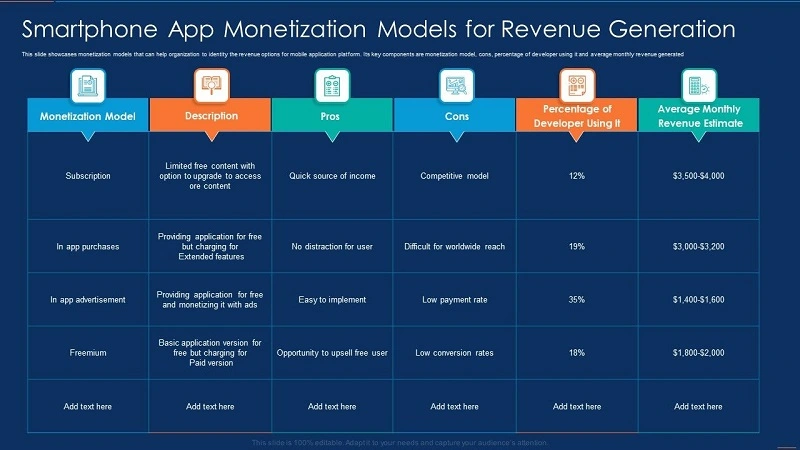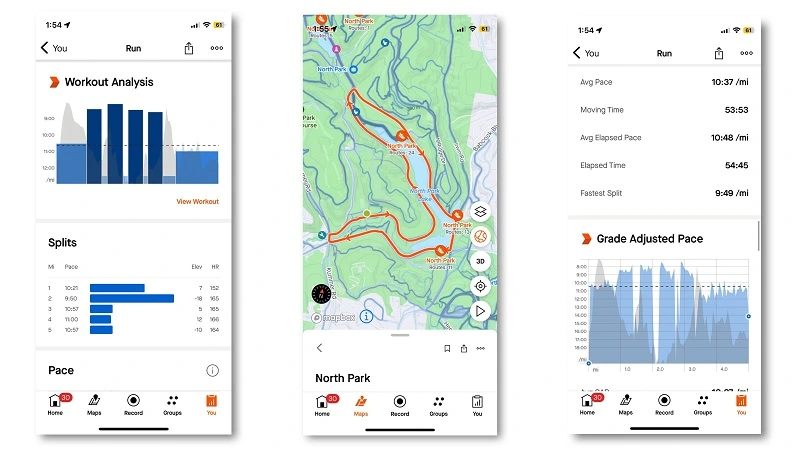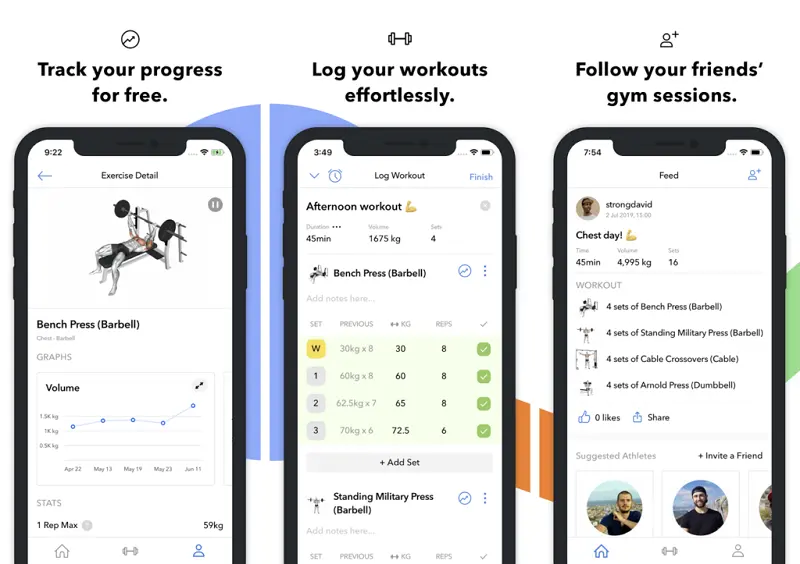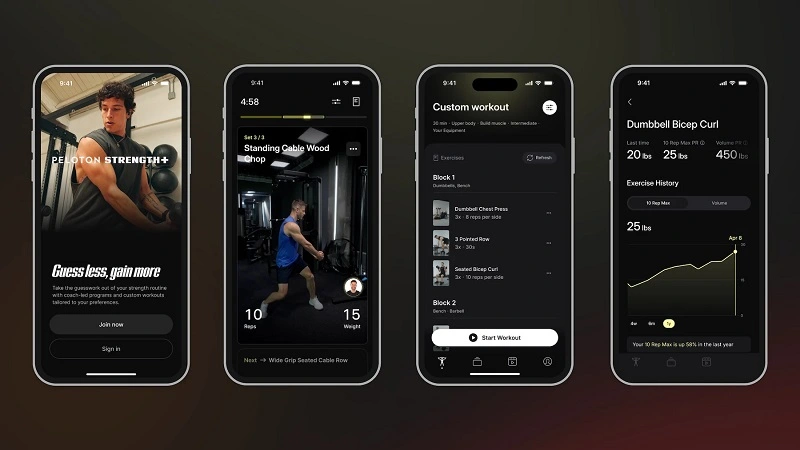Key takeaway: How much does it cost to make a fitness app?
It’s hard to state an exact number without knowing about the type or complexity. For example, a fitness app with performance tracking, geolocation and personalization features costs more than a simple workout planning app. Read on to learn the concept of estimating and calculating an app development price.
For now, here’s a quick comparison and overview of fitness app development cost.
| App size | Key features | Time | Team size | Cost |
|---|---|---|---|---|
| Prototype & MVP | UI/UX design with 2 to 3 main features | 1-4 weeks | 2 to 4 | <$30,000 |
| Simple | – User registration – Workout tutorials & planning – Personalized goals – Manual tracking – Social sharing. | < 3 months | 3 to 5 | <$70,000 |
| Medium | – All basic features – Geolocation – In-app purchase – Wearable devices integration for tracking – Activity tracking – Online coaching & messaging – Personalized workout plans. | <8 months | 4 to 7 | <$120,000 |
| Complex | – All basic and medium features – Live stream and on-demand content – AI-powered features – Gamification. | 6 months to 1 year+ | 5 to 10 | $150,000+ |
Why is developing a fitness app expensive?
There are many factors contributing to the final cost. By understanding these, you can easily trim them down for cost-effective development. Of course, this is a trade. With each factor, we will hand out some tips to optimize the fitness app development cost.
Platform choice
Native app development costs the most, as you have dedicatedly built them for iOS and Android. The time it takes is longer since you can’t reuse the codebase. The plus side? A native app runs faster and performs better, with less problems in security and downtimes.
Some businesses opt for cross-platform or hybrid development to save some cost. Cross-platform allows you to reuse the code base for any platform of choice, with notable technologies like Flutter or Xamarin.
If you have a simple fitness app with basic features or an MVP, some might opt for hybrid development. This allows users to flexibly use the app on mobile and web browser like a PWA. However, both cross-platform and hybrid development are not suitable for highly complex fitness apps.
In the US, you would expect to pay around:
| Type | Cost |
|---|---|
| Native iOS development | $70 to $100/hr/developer |
| Native Android development | $50 to $80/hr/developer |
| Cross-platform development | $40 to $80/hr/developer |
| Hybrid development | $40 to $70/hr/developer |
Keep in mind that the price can change based on tech stack, programming languages (for example, Golang or Swift developers cost more than JavaScript developers, as the talent pool is smaller) and developer’s location.
App size & complexity
As mentioned above, the more features you want to add, the higher the price. Some features take less hour to build and implement, hence costing less.
Here’s another breakdown:
| Feature | What to have | Average cost |
|---|---|---|
| User login | – Google, Facebook, etc. sign in option – New profile signs up – Password recovery – Verification option (the more layer you want to add, the higher the cost) | $5,000 to $10,000 |
| Profile and app settings | – Edit profile – Edit app setting: data preference, mobile access – Dark or light screen. Notification settings. | $3,000 to $7,000 |
| Social sharing | The more social channel you add, the higher the price. Most common contents for social sharing are personal achievements and workout plan. | $500 to $5,000 |
| Personalized workout plan | – Data analytics to suggest suitable workout based on each profile and user behavior – Video tutorials: On-demand and live videos will cost more. | $7,000 to $20,000 |
| Gamification | – Game-like features to encourage users – Reward and loyalty program | At least $10,000 |
| Chatting and Social | Social-like feature that users interact together | At least $7,000 |
| Geolocation | Tracking step, distance, activity, physical performance | At least $5,000 |
| In-app payment | – Marketplace – Integration with payment method: the more you have, the higher the total price | At least $10,000 |
The latest fitness apps nowadays don’t stop at simple tracking and workout planning. To offer better services, many apps integrate with AI to enhance their suggestion and personalization, IoT connection with wearables to improve accuracy in tracking, AR/VR for exceptional practice experience, or blockchain to secure payment.
All these additional technologies lead to high fitness app development costs. But it will give you a competitive edge in this highly competitive market.
Integration with wearables and third-party apps
Different levels of integration will cost differently. Connecting your fitness app with a sensor or wearable allows real-time tracking and timely suggestion, futher enhancing user retention. Bear in mind that:
- Each vendor requires different APIs and BLE communication protocols. Some have OpenAPI that you can seamlessly integrate with no sweat. Other requires custom API, adding to the total cost.
- Data synchronization: Ensure your data transferring is accurate, timely, and seamless.
Each integration can cost from $3,000 to $10,000. Here are the most common ones:
| Integration type | Common examples | Average cost |
|---|---|---|
| Wearable device | Google Fit, Apple Health, Fitbit | $5,000 to $10,000 |
| Payment Gateway | Paypal, Stripe | $3,000 to $8,000 |
| Nutrition database | MyFitnessPal | $2,000 to $5,000 |
| Live Streaming, Video meeting | Zoom, Google Meet, Vimeo | $5,000 to $15,000 |
UI/UX design requirements
A friendly interface will help your user navigate faster and spend more time using your app. You can either adjust already-made templates with simple layout, basic color themes and standard button. This is more cost-effective but can be too generic.
Or you can opt for a more creative approach that sets your brand apart, you need to invest in custom brand design (logo, brand guidelines), and UI/UX design.
3D elements, interactive images, dark mode, and complex animations will also take more time and cost to build. They are flashy, but if not necessary, you can cut them to optimize the fitness app development cost.
| Role | Hourly rate |
|---|---|
| Graphic designer (Logo, Icon, Brand design elements) | $20 to $45 |
| UI/UX designer | $30 to $60 |
| Front-end developer | $40 to $80 |
Development team
The above hourly rate is from the US and EU, meaning that developers from other regions can take much less. For example, with haft the price, you can easily hire an experienced developers from Vietnam or India.
The price to hire a full development team from Business analyst, designer, developer, to quality assurance mostly depends on location and experience level. Choosing who and where your partner is can increase or decrease the fitness app development cost.
| Roles | Location | Hourly rate |
|---|---|---|
| UI/UX designers | US & EU | – Junior: $25/hr – Middle: $30 to 50/hr – Senior: $50+/hr |
| Vietnam & India | – Junior: $15/hr – Middle: $20/hr – Senior: >$30/hr | |
| Mobile app developers | US & EU | – Junior: $30 to $40/hr – Middle: $40 to $60/hr – Senior: >$60/hr |
| Vietnam & India | – Junior: $15 to $20/hr – Middle: $20 to $35/hr – Senior: >$40/hr | |
| Testers/ Quality assurance | US & EU | – Junior: $20 to $35/hr – Middle: $35 to $50/hr – Senior: >$50/hr |
| Vietnam & India | – Junior: $10 to $20/hr – Middle: $20 to $30/hr – Senior: >$30/hr |
The hourly rate is affected by the living standard of the region, economy and currency exchange rate. Therefore, just because they are more affordable doesn’t mean they are less qualified.
Cost optimization tips: Based on Clutch and Hacker Rank report, Vietnam has exceptional quality yet very underrated. They even stand higher than India in quality and have larger talent pool than many EU-based countries and the US. Yet their price is twice as economical.
Offshoring outsourcing opens many opportunities to quickly assemble a talented team for your project.
Learn the ranking of top IT Outsourcing coutries with backed data!
Other hidden costs
Despite not taking a large portion, these hidden fitness app development costs can quickly increase if they are not well-managed.
Consultation cost: Much like developers, consultants count their work based on hourly rate. They can help you sort out technological aspects, go-to-market strategy, and business management.
Cost optimization tips: Some software development companies, like Synodus, also offer IT consultation during projects without additional costs.
Maintenance cost: Expect something from 15% to 20% of your initial fitness app development cost per year for this. If you require post-launch support, it can take a few more cost. If you’ve already had an in-house team, you can ask the developers to transfer documentation and knowledge to manage yourselves.
Non-functional requirements: In case you want to make your app HIPAA, FDA, or GDPR-compliant for better user safety, you need to hire qualified developers and partners that can navigate these standards.
Monetization model: How will your fitness app generate revenue? This can also add more features to your app, hence increasing the final cost. For example, if you opt for subscription-based model, you need to add tier-based personalization, loyalty program, CRM integration. If you want to earn money through selling in-app and physical products, you should include a marketplace and eCommerce features.

Real-life examples of fitness app development cost per type
There are too many things to count! I understand. All these above might still be too hard to estimate. Let’s look at some of the most common fitness apps and learn how much you might need to invest.
Sport training and tracking app like Strava
Strava stands out with their stellar user experience and a wide range of integration for activity and sport tracking. Here are some of the notable features, if you want to build a like-minded app:
- GPS tracking and wearable integrations.
- Data analysis and performance management.
- Personalized training programs: Route discovery, Workout planning.
- Community management: Social sharing, Rewarding, Global challenges.
An app like Strava can be categorized as a complex one, since they offer detailed analytics, gamification, social networking, and complex integration. Therefore, it can cost more than $100,000.

However, if you want simple fitness tracking, user profiles, and video-based training, it’s only around $50,000 to build.
Gym workout app like Hevy
To build a specialized app for gym planning and workout tracker like Hevy, you need to prepare around $70,000. Hevy is less complex than Strava, yet still contains many selling features such as:
- Desktop and mobile version.
- Workout logging.
- Progress tracking.
- Gym community where you can share your progress, workout plan, interact with others, and join leaderboards challenges.
- Integration with wearables.
- Coach assign.
If you focus solely on 1 sport, instead of many like Strava, the final fitness app development cost will be less.

Personal trainer app like Peloton
If you want to build a fitness app made for fitness equipment and wearable devices, Peloton is a prime example. With over 6 million users worldwide, Peloton isn’t a normal personal trainer.
- Live and on-demand class with instructor from 10 different sports.
- Real-time feedback with customized training.
- Virtually workouts such as scenic rides and runs.
- Integration with entertainment app.
- Performance tracking and Leaderboards.
Apps like Peloton require advanced API integration and a large content library. For this, you need to invest anything from $120,000 to $150,000+.

Diet and nutrition tracking app like MyFitnessPal
Building a calorie tracker and BMR calculator like MyFitnessPal is simpler than Peloton, Strava or Hevy. It usually cost around $50,000 with basic features such as:
- Meal and calorie tracking.
- Health metrics, BMR calculator.
- Meal planning.
If you want to add more workout-related features, the cost will increase.
Cost comparison between Outsource, In-house, No-code
How you build your development team can also change the total fitness app development cost. The most common ways are Outsourcing and building your In-house team. Let’s take a look of how much each cost:
| Outsourcing | In-house team | |
|---|---|---|
| Pros | – Cost-effective as you can work with people outside your region. (nearshoring or offshoring) – Instant onboarding – Larger and more diverse talent pool – Vendors taking care of HR management and recruitment. | – Full control of your team and development process – Fully understand your business vision and strategy. |
| Cons | – Shared control – Communication and time challenges – Not fully understand your business strategy. | – Take time to hire, onboarding and training – Limited talent pool to local – Expansive, risk of not being able to hire the right people instantly for the job. |
| Cost factor | – Location (nearshoring is usually higher than offshoring to Asia, for example) – Currency exchange rate – Living standard in said region – Estimated hours of work & project complexity. | – Average salary for the position and the level in local region – Team size – Recruiting, onboarding, training cost. |
| How to pay | – Staff Augmentation: hire only the vacant position and pay per hour of work – Project-based: hire a full team for your project – Pay by fixed cost or hour of work – Time & Materials: pay by hour of work and delivery – Fixed cost: pay a defined amount before development. | Salary and bonus based on the agreement between employee and employer |
| Estimation | Outsourcing to Vietnam is much more cost-effective than US or EU, as explained above. IT outsourcing is also 2x times effective than hiring an in-house team, but it shouldn’t be a long-term strategy | Managing an in-house team yourself will add in extra HRM costs and sunk cost of not having the right people on time. |
| Best for | – Business with limited budget – Businesses need to fill a team quickly – Early-stage startup that needs quick validation – High-risk product. | When you have validated your idea, generated income, and ready to expand your team. |
Each method has its good and bad. With IT Outsourcing, you can quickly onboard a well-versed team of 5 from Vietnam or India with $100 to $150 per hour. Yet hiring an in-house team requires at least 1 to 2 months to fully onboard every position. You have to follow the average salary of the region, which can lead to $50 per hour for 1 developer in the US.
Cost optimization tips: For early-stage startup, you can work with an outsource team to quickly build your MVP for validation and pitching, before investing in a full team right away. When the risk is still high, IT outsourcing is a good way to optimize the budget.
For example, at Synodus, we have a 3-day framework to build an MVP, allowing you to validate your product quickly with the most optimized budget.
Another way to quickly have your MVP is using a low-code no-code platform such as Bubble, Airtable, Appsheet, Appian, etc. With around $20 to $100 per month, depending on the number of user and screen, you can have your app immediately.
However, this method is best for prototype and MVP development. You need to create a stronger back-end later for a full-fledge product.
Breakdown of fitness app development cost per phases (with optimization tips)
Another way to calculate your fitness app development cost is based on development phases. Using this will help you define which stage can be optimized and which shouldn’t.
This estimation is based on our experience in developing over 70+ mobile apps.
Discovery (Product, market, and business analysis)
This is where everything starts. You and your vendor dive deep into the market research, define user needs, plan the development roadmap, and draft a prototype or POC. From there, the vendor can seamlessly integrate with your team, align with your vision, and avoid any potential roadblocks mid project.
Must-have output:
- Clear expectations and goals.
- Development roadmap with detailed milestones.
- Estimated cost and human resources for the project.
- A POC on app architecture, used tech stack, and other technological aspects.
Estimated time: 3 to 10 days, depending on project’s complexity.
Involved roles: Business Analytics, Project Manager, Product Owner.
% on total fitness app development cost: 5%.
Cost optimization tips: At Synodus, we do not take this phase for granted. Many overlook this and have to pay extra costs to redefine the project, redevelop the system, rebuild the app later.
One client came to us after a failed project with his ex-partner, doubling the entire development time and cost. After learning his case and expectation carefully, we delivered it in 4 months with up to 60% development cost saved.
Prototyping and UI/UX design
Once you have your plan sorted out, visualize it to kickstart the process. In this phase, we will shape the user path through your fitness app, identify how they will interact and navigate the system.
More than 30% of users uninstall an app due to a poor design or hard to navigate. You need to learn your ICP’s preference and answer how they will get to their answer the fastest. Keep in mind that users from different regions might have different expectations.
Must-have output:
- UI wireframes
- UX mapping to present user flow.
- Prototype that you can interact to mimic potential users on the app.

Estimated time: 2 weeks to 5 weeks, depending on project’s complexity.
Involved roles: UI/UX designers, Project Manager, Product Owner, Business Analytics (optional).
% on total fitness app development cost: 10% to 15%.
Development stage
The most extensive process to bring your fitness app to life. You have to closely work with the team to ensure everything is on the right track. Any changes during this step will cost extra time and money.
Key activities:
- Front-end development based on UI/UX design.
- Back-end development for a secure and scalable server-side architecture to process data.
- Integration with third-party or wearables.
Estimated time: 2 months+, depending on the project’s complexity.
Involved roles: Developers, Project Manager.
% on total fitness app development cost: 60 to 70%.
Cost optimization tips: Development methods are extremely important to optimize your budget, especially when working with an IT outsourcing vendor.
Some vendors rely on Agile and Time & Materials payment. While others approach it with Waterfall and Fixed payment. Both have their pros and cons. The first can easily lead to cost overrun and project delay, but the latter is rigid and not open for iteration.
At Synodus, we use both effectively to get the best of them. For example, Agile is most suitable for iterative phases such as Discovery, Design, and Quality Assurance. But Waterfall proves their best during Development phase. This makes sure you are on track, stay on budget, and get quality code.
By doing this, we can deliver 3x times faster and save 63% on development costs for a fitness client.
Have an idea but don’t know where to start?
Quality assurance stage
During this phase, you test and test your fitness app in various scenarios and settings. This includes:
- Functional setting to see if every feature is well-functioned.
- Usability testing to see if your app is easy to navigate and intuitive.
- Compatibility testing to see how well it functions across devices and platforms.
- Performance testing to see how your app performs without slowdowns under large usage, high volume of data and traffic.
- Test if your fitness and wellness app match regulatory standard and app store requirements.
- Audit security issues, firewall, and bugs.
Estimated time: 3 weeks to 8 weeks, depending on the project’s complexity.
Involved roles: Tester, Quality Assurance, Developers, Project Manager, Product Owner.
% on total fitness app development cost: 10%.
Cost optimization tips: This phase and development phase can go alongside together. You don’t have to wait until the development is done for testing.
You can break it down piece by piece. For example, for a fitness tracking app, you can prioritize developing User profile setting first, test it, then move onto tracking ability. This will speed up the development process and help you quickly navigate issues early on.
Deployment and launching
The final step to make your fitness app available anywhere for all users. Make sure your deployment is followed by a smooth launch with optimal performance.
Estimated time: 3 days to 1 week, depending on the project’s complexity.
Involved roles: All team members
% on total fitness app development cost: 5%.
Wrapping up
Fitness app development cost can range anywhere from $30,000 to $200,000. Depending on many factors, you can easily optimize your investment by working with an offshoring outsourcing team, adjusting your development method, building with iteration, or starting small with an MVP before full on investment.
How useful was this post?
Click on a star to rate it!
Average rating / 5. Vote count:
No votes so far! Be the first to rate this post.




